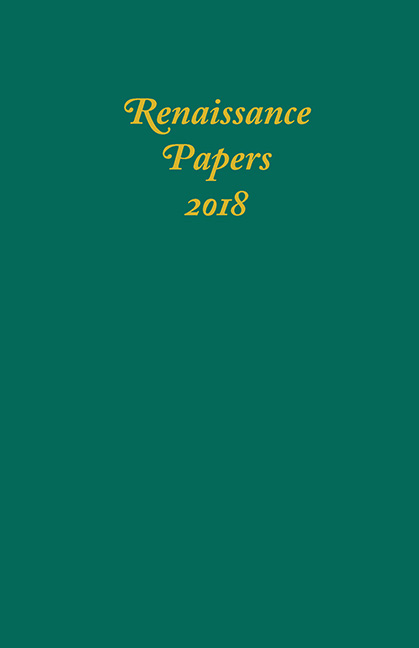Book contents
- Frontmatter
- Contents
- Renaissance Papers
- “One Little Room, An Everywhere”: Staging Silence in London's Blackfriars and Shakespeare's Henry VIII
- “What they are yet I know not”: Speech, Silence, and Meaning in King Lear
- Shakespearean Epiphany
- Between the “triple pillar” and “mutual pair”: Love, Friendship, and Social Networks in Antony and Cleopatra
- “Beauty Changed to Ugly Whoredom”: Analyzing the Mermaid Figure in The Changeling
- Imagining the Other in a Cuzco Defense of the Eucharist
- A Critique of Poor Reading: Antissia's Madness in The Countess of Montgomery's Urania
- “Thou thyself likewise art lyttle made”: Spenser, Catullus, and the Aesthetics of “smale poemes”
- The ordo salutis: Sacred Circularities in John Donne's “Good Friday 1613. Riding Westward”
- “Broken-Backed” Texts: Meritocracy and Misogyny in Ben Jonson's The Forrest
“Beauty Changed to Ugly Whoredom”: Analyzing the Mermaid Figure in The Changeling
Published online by Cambridge University Press: 21 March 2020
- Frontmatter
- Contents
- Renaissance Papers
- “One Little Room, An Everywhere”: Staging Silence in London's Blackfriars and Shakespeare's Henry VIII
- “What they are yet I know not”: Speech, Silence, and Meaning in King Lear
- Shakespearean Epiphany
- Between the “triple pillar” and “mutual pair”: Love, Friendship, and Social Networks in Antony and Cleopatra
- “Beauty Changed to Ugly Whoredom”: Analyzing the Mermaid Figure in The Changeling
- Imagining the Other in a Cuzco Defense of the Eucharist
- A Critique of Poor Reading: Antissia's Madness in The Countess of Montgomery's Urania
- “Thou thyself likewise art lyttle made”: Spenser, Catullus, and the Aesthetics of “smale poemes”
- The ordo salutis: Sacred Circularities in John Donne's “Good Friday 1613. Riding Westward”
- “Broken-Backed” Texts: Meritocracy and Misogyny in Ben Jonson's The Forrest
Summary
IN Thomas Middleton and William Rowley's The Changeling, the duplicitous nature of Beatrice-Joanna has led some scholars to question whether her character arc is either a continual regression or a constant. Henry E. Jacobs notes, “rather than changing, Beatrice-Joanna may simply be exposing progressively more elements of her consistent personality.” He continues to address the concepts of character and perspective in a broader context, asserting that “the paradox of coextensive change and constancy is equally applicable to life as it is to art.” Indeed, Beatrice-Joanna's self-conscious mutability from chaste daughter of an upper-class family to conniving lover of her father's servant, De Flores, reveals a search for autonomy in an ordered and restrictive society. Moreover, this search for autonomy reflects the inconsistent categorizing of women in early modern Europe. Constance Jordan addresses how a woman’s socioeconomic and spatial restrictions in the “domestic and private” realm, apart from the “civic and public” realm, were “predicated on a woman's limited or defective humanity.” This subordinate classification according to sexual difference, as sixteenth-century Venetian writer Lodovico Dolce attests, was the very reason that the woman was primarily educated in “religion and moral virtue; her salvation … closely tied to her willingness to behave as a natural inferior.” Both the church and the law deemed that women were more susceptible to moral fallibility and therefore regulated their behavior and conduct to ensure that they were chaste, virtuous, and subservient to male authority. The perception of Beatrice-Joanna as morally corrupt, therefore, is as much of a social construct as her performance in the play. This binary depiction of the woman as both deviant of and compliant to social convention captures the essence of the siren, or mermaid, a popular figure in Renaissance culture. Tara E. Pederson posits that ”… those elusive and captivating hybrids, dominated the cultural imagination in early modern England in complex and multifaceted ways as they brought women and animal together,” and moreover, “the woman was frequently represented within and integral to sixteenth and seventeenth century English culture.” The Changeling does not provide any visual or textual description of a mermaid, but its subtext uniquely posits the mermaid as a metaphor for Beatrice-Joanna's transformation from guileless to conniving, from chaste to sensual.
- Type
- Chapter
- Information
- Renaissance Papers 2018 , pp. 55 - 66Publisher: Boydell & BrewerPrint publication year: 2019



